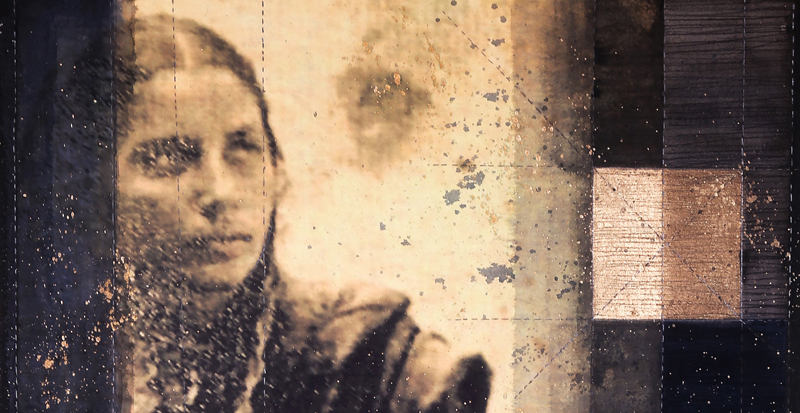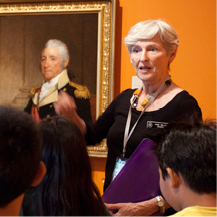
FOR IMMEDIATE RELEASE
May 1, 2017
Media contacts:
Scott Whelden
Tel: 808-532-8719
Email: swhelden@honolulumuseum.org
ART AT HoMA: WHAT'S ON VIEW THIS SPRING

HONOLULU, HAWAI‘I—While the big exhibitions Shahzia Sikander: Parallax, Artists of Hawai‘i 2017, and HoMA Select continue to draw viewers, spring brings a series of smaller, diverse exhibitions, giving visitors a chance to explore the work of Pakistani artist Noorjehan Bilgrami, warming textiles from around the world, and the photographs of Maui-based Christopher Cole.
Noorjehan Bilgrami: Under the Molsri Tree
May 18–Sept. 3, 2017
Karachi-based
artist Noorjehan Bilgrami’s photomontages in Under the Molsri Tree pay homage to the fragrant, blossomed trees
beneath which she played as a child in Hyderabad, India. Referencing history
through family photographs from the early 20th century, these large-format,
sepia tone works serve as sites of memories with questions of dwelling and
passage forming a rich, ambivalent landscape. (Detail pictured above.)
The exhibition also includes Safar—a series of small installations that is the result of a year Bilgrami spent in Japan learning the art of indigo dyeing, known as shibori. Safar emphasizes the delicate nature of mulberry paper, layered in indigo with applied gold and silver pigment, contrasted with small bundles of muslin and silk.
The exhibition is presented in partnership with Shangri La: A Museum of Art, Culture & Design, where Bilgrami will be artist in residence from May 4 to 19. In addition she will give a one-day indigo workshop at the Honolulu Museum of Art School.
Public programs:
The Romance of
Indigo: Artist Talk with Noorjehan Bilgrami
May 7 • 3-4:30 p.m.
Fishcake, 307c
Kamani Street, Honolulu
Indigo Submerged Workshop
May 13 • 9
a.m.-3 p.m.
Honolulu Museum
of Art School
Online
registration required: honolulumuseum.org/learn/classes
Global Warming: Quilts, Coverlets and
Blankets
May 18–Sept. 17, 2017
Curator of
textiles Sara Oka mined the museum’s textile collection to put together this
fascinating exhibition of works from around the world that provide protection,
warmth, security and comfort, but also are also key cultural traditions and
handmade records of history. Made from wool, silk, and cotton, these works were
worn as emblems of status, displayed as ceremonial banners, presented as
tribute cloth or used in trade.
Works on view include a Bhutanese charkep (rain blanket), a woman’s houli (drape gown) from Tunisia, an elegantly embroidered Uzbeki suzani (meaning “needlework”) and a Japanese kimono-shaped yogi—an example of the bed covers often given to a groom’s family to celebrate a marriage. Global Warming offers a glimpse into shared geometries, auspicious motifs and fertility symbols around the world.
Christopher Cole: The Global South
Through July 9
The museum continues its contemporary
Hawai‘i artist program in the John Dominis and Patches Damon Holt Gallery with
this series by Maui-based photographer Christopher Cole. He uses a 1950s large-format
8x10 view camera with a specialized lens, allowing him to create photographic
prints on a grand scale that capture the enormity of his subject matter as well
as incredible detail within the landscape/cityscape.
The Global South documents settlements on the margins of urban centers such as Kabul, Afghanistan; Kathmandu, Nepal; and Mexico City, Mexico, and exists in the margins between documentary and fine art photography. Viewers are encouraged to study the photographs to notice subtleties that may offer a glimpse into the lives, as well as challenge assumptions, about the urban poor in the developing world.
Raised on O‘ahu, Christopher Cole studied photography at The Corcoran Gallery, Washington D.C., and at Sarah Lawrence College, New York, before pursuing graduate studies in anthropology at the London School of Economics. His photographs have been exhibited at galleries in Hawai‘i and New York City. He received a 2016 recognition award from the Hawai‘i State Foundation on Culture and the Arts, as well as awards from NATO and the U.S. Departments of State and Defense for his humanitarian aid work. He is the son of Hawai‘i entrepreneur and philanthropist David Cole.
Camouflage Rhythms: Artwork by Juliette
May Fraser
Through Sept. 17
This exhibition features
oil and watercolor paintings created by Hawai‘i artist Juliette May Fraser
during World War II, when she worked side-by-side with lei sellers making
camouflage nets for the Army Corps of Engineers. Artists such as Fraser were
recruited for their acumen with color, composition, and the painting and dyeing
process. Lei sellers and fishnet makers were recruited for their expertise in
weaving techniques and agile hands, and their deep knowledge of the Hawaiian
environment where the camouflage nets were used to conceal military equipment.
In an unexpected yet highly productive arrangement, Fraser and the lei sellers developed a system consisting of cutting burlap and recycled fabric into strips, dyeing and configuring the strips to blend in with specific areas around the islands, and then weaving the strips onto large-scale nets, often completed while singing Hawaiian songs.
This scenario emerged as a result of economic changes after the attack on Pearl Harbor on Dec. 7, 1941. Hawaiʻi’s economy felt the impacts of war almost immediately, especially when the U.S. government requisitioned commercial passenger ships for military service in the weeks following Dec. 7. Ships that transported goods to and from the islands were used to transport construction and military supplies, and the luxury liners that once brought tourists were re-purposed to bring construction workers and military service men and women to Hawaiʻi as part of what has become the military complex. By January 1942, the influx of American military personnel arriving by ship in place of wealthy vacationing travelers brought the booming lei-selling industry to a screeching halt. The painter and lei sellers adapted to the economic shifts and secured work that allowed them to continue being artists, in an entirely new context.
Illustrating the Modern Novel: The Art of
Mizuno Toshikata
Through June 18
Every two
months, the museum’s Asian Art Department installs a new selection of woodblock
prints from the museum’s collection of more than 10,000 prints. The current
exhibition focuses on the work of Mizuno Toshikata, one of Japan’s most
prolific artists in the genre of kuchi-e, the multicolor, woodblock-printed
frontispieces featured in popular fiction that were produced from the 1890s
through the 1910s.
Educational reforms after the Meiji Restoration of 1868 dramatically improved the literacy rate of Japanese women. In response to this new audience, literary journals such as Literary Club (Bungei Kurabu, published 1895–1933) featured serialized romance novels that were illustrated with a kuchi-e print, folded into thirds and included at the beginning of the magazine. While the artwork was originally intended to depict a scene from one of the stories, due to strict publication deadlines and the time-intensive nature of woodblock printmaking, by around 1902, artists began to produce “stand-alone” kuchi-e (frequently portraits of beautiful women) that had no direct connection to the narratives. Around 1914, the rising popularity of photography and lithographic prints led to the death of kuchi-e as a genre. Nevertheless, recent publications such as A Survey of Woodblock Kuchi-e Prints (Mokuhan kuchi-e sōran) by Yamada Nanako (b. 1939) have drawn attention to the aesthetic value and art-historical importance of these often overlooked artworks.
Mizusashi: Japanese Water Jars from the
Carol and Jeffrey Horvitz Collection
Through June 11
The water jar
(mizusashi), usually made of ceramic, has a significant role in the
Japanese chanoyu tea gathering. The 16 mizusashi in this
exhibition are on loan from Carol and Jeffrey Horvitz, who have one of the
finest, most extensive collections of contemporary Japanese ceramics in the
U.S. The water jars on view demonstrate the wide range of aesthetic
interpretations that 20th-century and contemporary Japanese artists have made,
melding tradition and innovation.
Highlights include a rough 1929 Shigaraki-clay stoneware covered jar by the famous potter Kitaoji Rosanjin (1883-1959), a ca. 1978 jar with overglaze enamels with a lacquer lid by Kiyomizu Rokubei VI (1901-1980), and a 2015 pumpkin-shaped water jar by Katsumata Chieko (b. 1950), who has become well-known for her playful, undulating biomorphic forms that challenge traditional Japanese notions about the ceramic medium and vessel forms.
-end-
To UNSUBSCRIBE, please click here.
To join, e-mail lgriffith@honolulumuseum.org , or call (808) 532-6091.
About the Honolulu Museum of Art
One of the world’s premier art museums, the Honolulu Museum of Art presents international caliber special exhibitions and features a collection that includes Hokusai, van Gogh, Gauguin, Monet, Picasso and Warhol, as well as traditional Asian and Hawaiian art.
Located in two of Honolulu’s most beautiful buildings, visitors enjoy two cafés, gardens, and films and concerts at the theater. The museum is dedicated to bringing together great art and people to create a more harmonious, adaptable, and enjoyable society in Hawai’i.
Locations:
Honolulu Museum of Art: 900 S. Beretania Street
Honolulu Museum of Art Spalding House: 2411 Makiki Heights Drive
Honolulu Museum of Art School: 1111 Victoria Street
Honolulu Museum of Art at First Hawaiian Center: 999 Bishop Street
Honolulu Museum of Art Doris Duke Theatre: 901 Kinau Street (at rear of museum)
Website: www.honolulumuseum.org
Phone: 808-532-8700
Hours:
Honolulu Museum of Art: Tues–Sat 10 am–4:30pm; Sun 1–5 pm; closed Monday.
Honolulu Museum of Art Spalding House: Tues–Sat 10am–4pm; Sun noon–4pm
Admission (permits entry to both museums on the same day):
$10 general admission; children 17 and under are free.
There’s a lot happening at the Museum!
![]()
![]()
![]()
![]()
Unsubscribe | Forward | View in browser
You are receiving this email because of your interest in the Honolulu Museum of Art.
Honolulu Museum of Art 900 S Beretania St Honolulu, HI 96814


